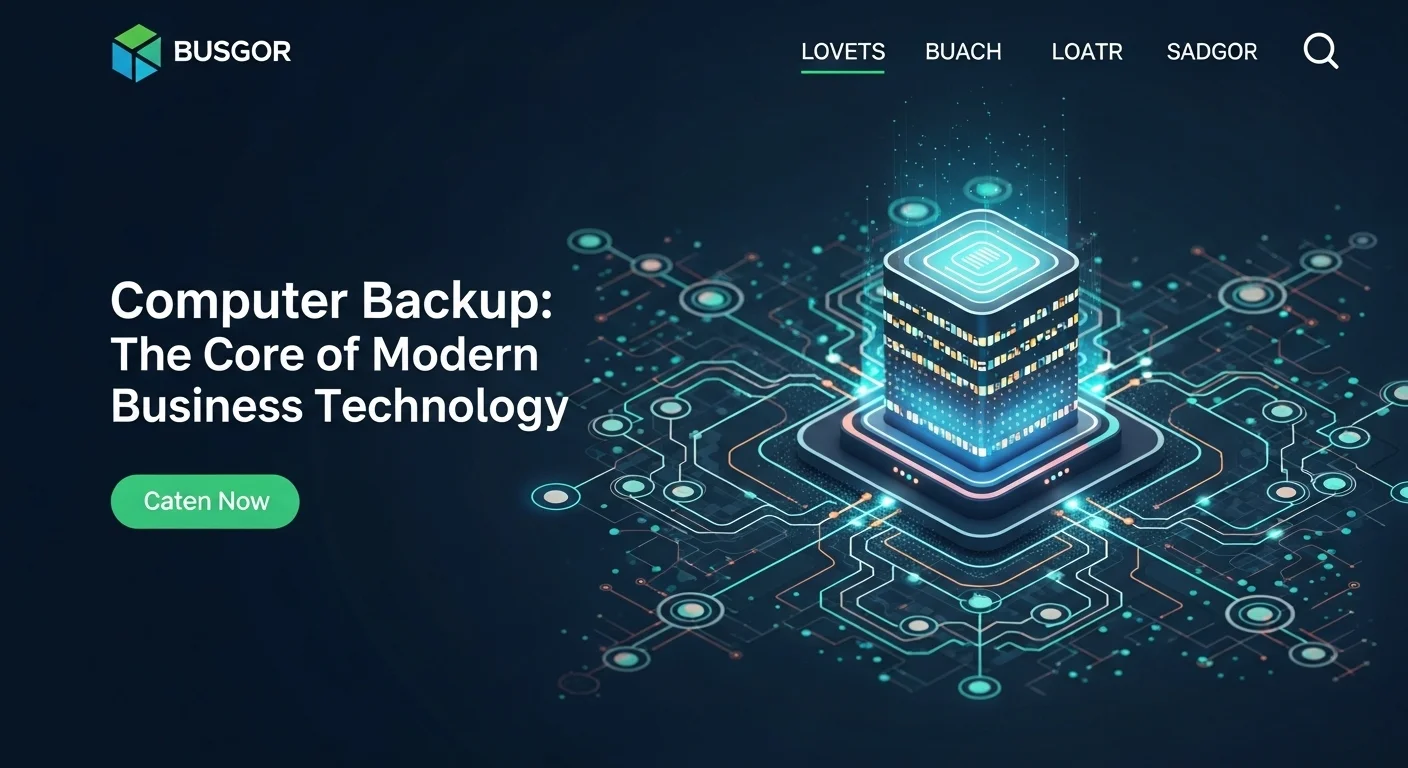The Ultimate Guide to Computer Backups: Your Business's Last Line of Defense

Executive Summary
In all my years in IT, I've seen one thing derail businesses faster than anything else: data loss. It’s that heart-stopping moment when a critical file vanishes or a server goes dark. That's why a solid computer backup strategy isn't just a technical task—it's the bedrock of modern business survival. This guide cuts through the jargon. We'll explore why backups are your best defense against threats like ransomware, how cloud services have changed the game, and what you actually need to keep your company running. Whether you're a small business owner trying to secure your client list or an enterprise architect building a resilient infrastructure, consider this your personal roadmap to mastering computer backups.
Table of Contents
- What is Computer Backup and Why Is It Important?
- Understanding the Common Causes of Data Loss
- The 3-2-1 Rule: Your Golden Ticket to Data Safety
- Why Backups Are a Core Business Strategy
- A Look at Backup Methods: Full, Incremental, and Differential
- Where Should Your Backups Live? Local vs. Cloud
- Business Solutions: What is Backup as a Service (BaaS)?
- The Non-Negotiable Best Practices for Backups
- Advanced Strategies for a Modern Tech World
- Understanding RTO and RPO: The Two Most Important Metrics
What is Computer Backup and why is it important in Technology?
In the digital world we live in, we hear the term 'computer backup' all the time, but its true weight is often misunderstood until it's too late. In simple terms, a backup is a second copy of your important data, stored somewhere safe in case the original is lost. But in reality, it’s a lifeline. It's the safety net that protects everything from your family photos to the entire operational data of a global company. The importance of having a good backup plan goes way beyond just getting a file back; it's the foundation of digital resilience, business continuity, and your primary defense against cyberattacks. Without a solid backup strategy, a business can face devastating financial losses, a tarnished reputation, or even complete failure. For you and me, data loss could mean losing irreplaceable memories, critical financial records, or years of hard work forever.
The Anatomy of Data Loss: Understanding the Enemy
To really get why backups are so critical, you need to understand the many ways your data can just disappear. These threats are everywhere and can hit without any warning. I've seen them all in my career.
- Hardware Failure: This is the most common culprit. Hard drives and SSDs don't last forever. They can die from old age, physical damage from a drop, a coffee spill, or a power surge. I've personally seen a brand-new server fail within a week of deployment. When your main storage device dies, any data that isn't backed up is likely gone for good, or you're looking at a very expensive recovery service with no guarantees.
- Software Corruption: Sometimes, the software itself is the problem. A bug in an application, a glitch in the operating system, or even just shutting down your computer incorrectly can corrupt files and make them unreadable.
- Human Error: We've all been there. That accidental 'delete' click on a crucial file or formatting the wrong drive can be a gut-wrenching mistake. Without a backup, a simple slip-up can have massive consequences.
- Cybersecurity Threats: This has become a huge problem. Viruses can corrupt your files, but the real nightmare is ransomware, which locks up all your data and demands a payment. In my experience, having a clean, disconnected backup is the only reliable way to recover from a ransomware attack without paying the criminals.
- Disasters and Theft: A fire, flood, or a simple burglary can wipe out your physical hardware. If your laptop or server is stolen, you've lost the device and all the data on it.
The 3-2-1 Rule: A Golden Standard in Backup Strategy
Given all these threats, the IT community came up with a simple but powerful rule of thumb: the 3-2-1 rule. It’s easy to remember and incredibly effective. I can't stress this enough—this isn't just a suggestion; it's the foundation of every solid recovery plan I've ever built.
- Have at least THREE copies of your data.
- Store these copies on TWO different types of media.
- Keep ONE of these copies off-site.
The logic here is all about eliminating single points of failure. Your first copy is the live data on your computer. Your second copy, maybe on an external hard drive, protects you if your computer's drive fails. The third copy, stored off-site in the cloud or at another location, is your safeguard against a disaster like a fire or theft that could destroy both your computer and your local backup. This rule is key when you're looking for the best computer backup services, as most are designed to handle that crucial off-site copy for you.
The Business Imperative: Beyond Data Recovery to Business Continuity
For any business, a backup plan isn't just an IT chore; it's a fundamental part of its survival plan. When data is inaccessible, business stops. Imagine your sales team can't access customer info, or you can't process payroll. Every minute of downtime costs money, productivity, and customer trust.
A strong backup strategy is a business superpower, providing:
- Minimal Downtime: With a reliable backup, you can restore your data and systems quickly after an incident, getting back to business with minimal financial damage.
- Regulatory Peace of Mind: Industries like healthcare and finance have strict data protection laws. Proper backups are essential to avoid massive fines and legal trouble.
- Brand Protection: A major data loss event can destroy your company's reputation. Recovering quickly shows your customers you're reliable and can be trusted with their information.
- A Competitive Edge: The business that can survive a disaster when its competitors can't is the one that will thrive. Resilience is a powerful market differentiator.
This is where professional computer backup services become invaluable. They offer the tools and expertise to implement these strategies seamlessly, often using cloud computer backup to secure your off-site copy. Going with online computer backup services lets you leverage enterprise-grade security without the massive cost of building it yourself.

Complete guide to Computer Backup in Technology and Business Solutions
Now that we've covered why backups are so essential, let's get into the practical side of things. This guide will walk you through the different types of backups and the solutions available, helping you choose the right system for your needs. The choices you make here—between local or cloud, and how you schedule your backups—will directly affect your recovery speed, costs, and overall security. For any serious business, using professional computer backup services is a critical part of this process.
Technical Methods: The Building Blocks of Backup
At the heart of it all are three main ways to copy your data. Think of it like making copies of a book you're writing.
1. Full Backup
This is the simplest method: you copy the entire dataset every single time. It's like photocopying the whole book from cover to cover.
- Pros: Restoring is incredibly easy and fast. You have everything you need in one single package.
- Cons: It takes a lot of time and uses the most storage space. Doing this every day isn't practical for large amounts of data.
2. Incremental Backup
This method only copies the data that has changed since the *last backup was performed*. It's like photocopying only the pages you edited since you last used the photocopier.
- Pros: Super fast and uses very little storage space, making it great for frequent backups throughout the day.
- Cons: Restoring is more complicated. You need the last full backup and every single incremental copy since then, in the right order. If one is missing or corrupt, your restore will fail.
3. Differential Backup
A differential backup copies all the data that has changed since the *last full backup*. It's like photocopying every page you've edited since you first wrote the book, every single time.
- Pros: A great middle ground. Restoring is much simpler than with incremental backups—you just need the last full backup and the latest differential copy.
- Cons: It uses more storage space than incremental backups, and the process gets longer each day until the next full backup is run.
In the real world, we almost always use a mix. A common strategy I recommend is a full backup once a week (say, over the weekend) followed by daily differential or incremental backups. This gives you a great balance of speed and reliability.
Deployment Models: Where Your Backups Live
After deciding how to back up, you need to decide where to store it. This choice is crucial for security and accessibility.
Local Backup
This means storing your data on a device physically near you, like an external hard drive or a Network Attached Storage (NAS) device. It's great for quick and easy access, but it's vulnerable to local disasters like fire, flood, or theft.
Cloud Computer Backup
High-speed internet has made cloud computer backup a game-changer. Your data is sent over the internet and stored securely in a professional data center. This is the core of what online computer backup services offer.
- Pros: It automatically fulfills the off-site rule (the '1' in 3-2-1), protecting you from local disasters. Your data is accessible from anywhere. The best services provide strong encryption and can scale as your data grows.
- Cons: Your first full backup can take a long time, depending on your internet speed. It's a subscription-based service, so there's an ongoing cost.
Hybrid Backup
Honestly, for most businesses I work with, a hybrid approach is the winning ticket. It combines the best of both worlds: you back up your data to a local device for fast restores of everyday mistakes, and you also replicate that backup to the cloud for ironclad protection against major disasters. Many of the best computer backup services are designed to make this hybrid model work seamlessly.
Business Solutions: Backup as a Service (BaaS)
For businesses, managing all of this can be a headache. That's where Backup as a Service (BaaS) comes in. With BaaS, you subscribe to a service that handles everything for you—the software, the secure cloud storage, and the management, all in one package. When you search for computer backup online, you're often looking at BaaS providers. Think of it like hiring a dedicated 24/7 security team for your data, freeing up your own team to focus on growing the business.

Tips and strategies for Computer Backup to improve your Technology experience
Putting a backup system in place is the first big step, but the real work lies in making sure it's always ready and reliable. This is where we go from theory to practice. A backup plan shouldn't just be a document you file away; it needs to be a living, breathing part of your operations that you can count on when things go wrong. From automation to rigorous testing, these are the tips I share with every client to help them achieve true data mastery.
Best Practices: The Non-Negotiables of Backup
These are the absolute essentials. If you ignore these, even the most expensive backup system can fail you when you need it most.
1. Automate Everything
Manual backups are doomed to fail. We forget, we get busy, we go on vacation. The most critical step you can take is to automate your backup schedule. Every good backup software and computer backup service allows you to 'set it and forget it'. Your backups should run like clockwork in the background without anyone having to lift a finger. Automation means consistency.
2. Encrypt Your Backups
Your backup contains a copy of your most sensitive information. If it falls into the wrong hands, it's just as bad as losing the original data. You absolutely must encrypt your backups. Look for solutions that offer end-to-end encryption, meaning the data is locked down on your computer *before* it's sent anywhere. You should be the only one with the key. This protects you even if someone steals your backup drive or breaches your cloud provider.
3. Test Your Restores Regularly
Let me be very clear: a backup you haven't tested is just a hope, not a strategy. So many people back up data for years, only to discover during a crisis that the files are corrupt or unusable. You have to test your restores. It doesn't have to be a huge drill every week. Try restoring a single random file. Check an older version of a document. For businesses, I recommend doing a full test restore to a spare server every quarter. Testing proves your system works and makes you comfortable with the process, which saves precious time in a real emergency.
Advanced Strategies for a Modern Technology Environment
As technology moves forward, so should our protection strategies. Here are a few advanced ideas for a truly modern backup plan.
Integrating Backup with Cybersecurity
Your backup is your last line of defense against ransomware. For it to work, it must be isolated from your main network. The best computer backup services create an 'air gap' or use immutability—a feature that makes your backups unchangeable for a set period. This means even if an attacker gets into your system, they can't delete or encrypt your recovery points.
Leveraging AI in Backup and Recovery
Artificial intelligence is starting to play a huge role here. AI can predict hardware failures before they happen, spot signs of malware in your backups, and automatically optimize your storage to save money. When you're looking at online computer backup services, ask them how they're using AI to make their platform smarter and safer.
Considering RTO and RPO
For businesses, everything comes down to two key metrics. Don't let the acronyms scare you; they answer very simple questions:
- Recovery Time Objective (RTO): How long can my business afford to be shut down? Is it two hours? A full day? This answer determines how fast your recovery solution needs to be.
- Recovery Point Objective (RPO): How much data can my business afford to lose or re-do? Is it one hour's worth of work? Four hours? This answer determines how often you need to run your backups.
Defining your RTO and RPO is a business decision, not a technical one, and it will guide every choice you make about your backup technology. A service that allows you to perform a computer backup online every 15 minutes is perfect for a low RPO, while a system that can restore a full server in minutes is essential for a low RTO.
Expert Reviews & Testimonials
Sarah Johnson, Business Owner ⭐⭐⭐
This was a solid overview of computer backups, but as a small business owner, I would have loved to see more specific case studies or examples for my scale.
Mike Chen, IT Consultant ⭐⭐⭐⭐
A very thorough article on computer backups. It clarified a lot for me as an IT consultant, though a few of the more technical sections could be broken down even further for clarity.
Emma Davis, Tech Expert ⭐⭐⭐⭐⭐
Fantastic guide! As a tech specialist, I found this incredibly comprehensive and well-explained. It's a great resource for anyone in the field. Absolutely perfect.



